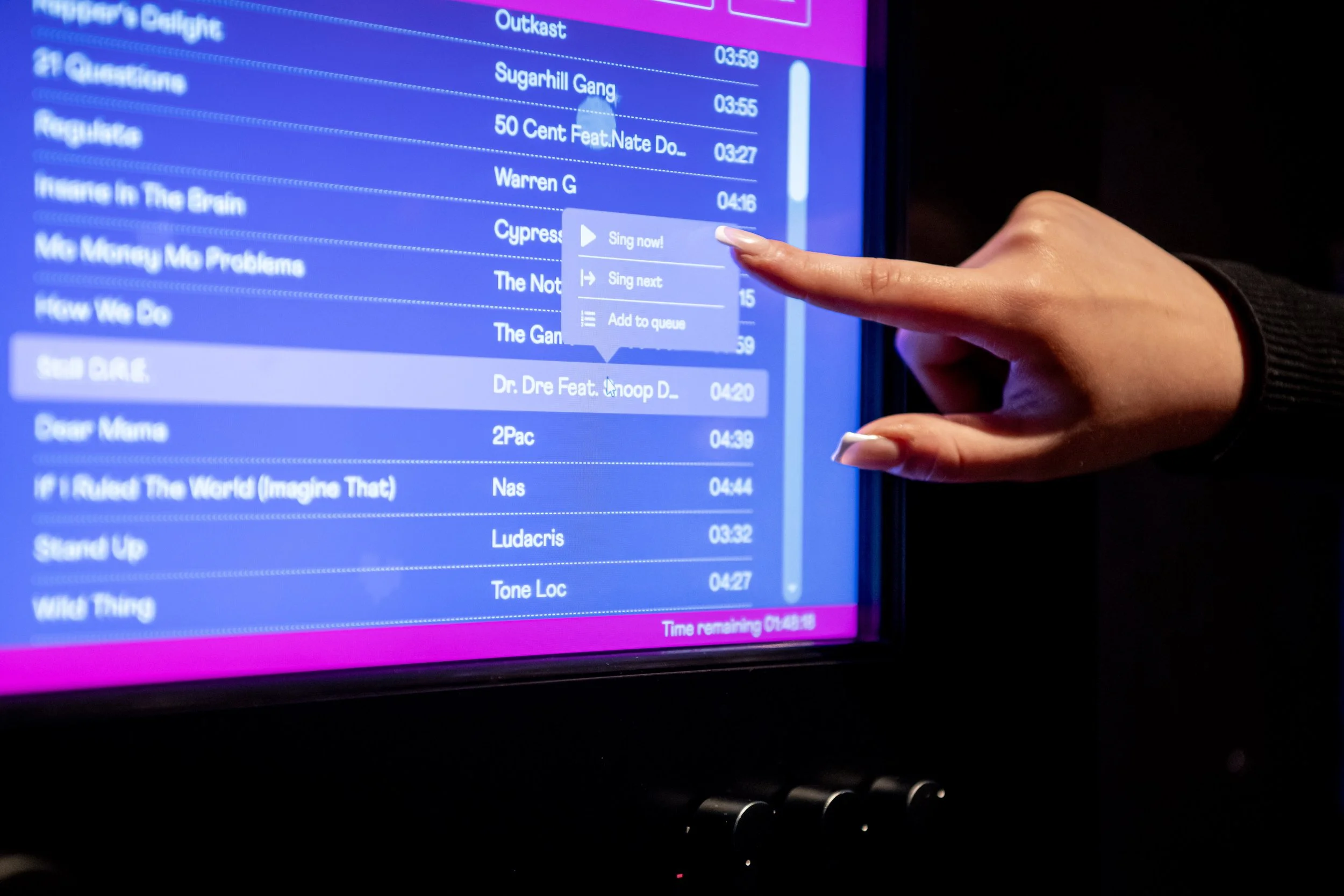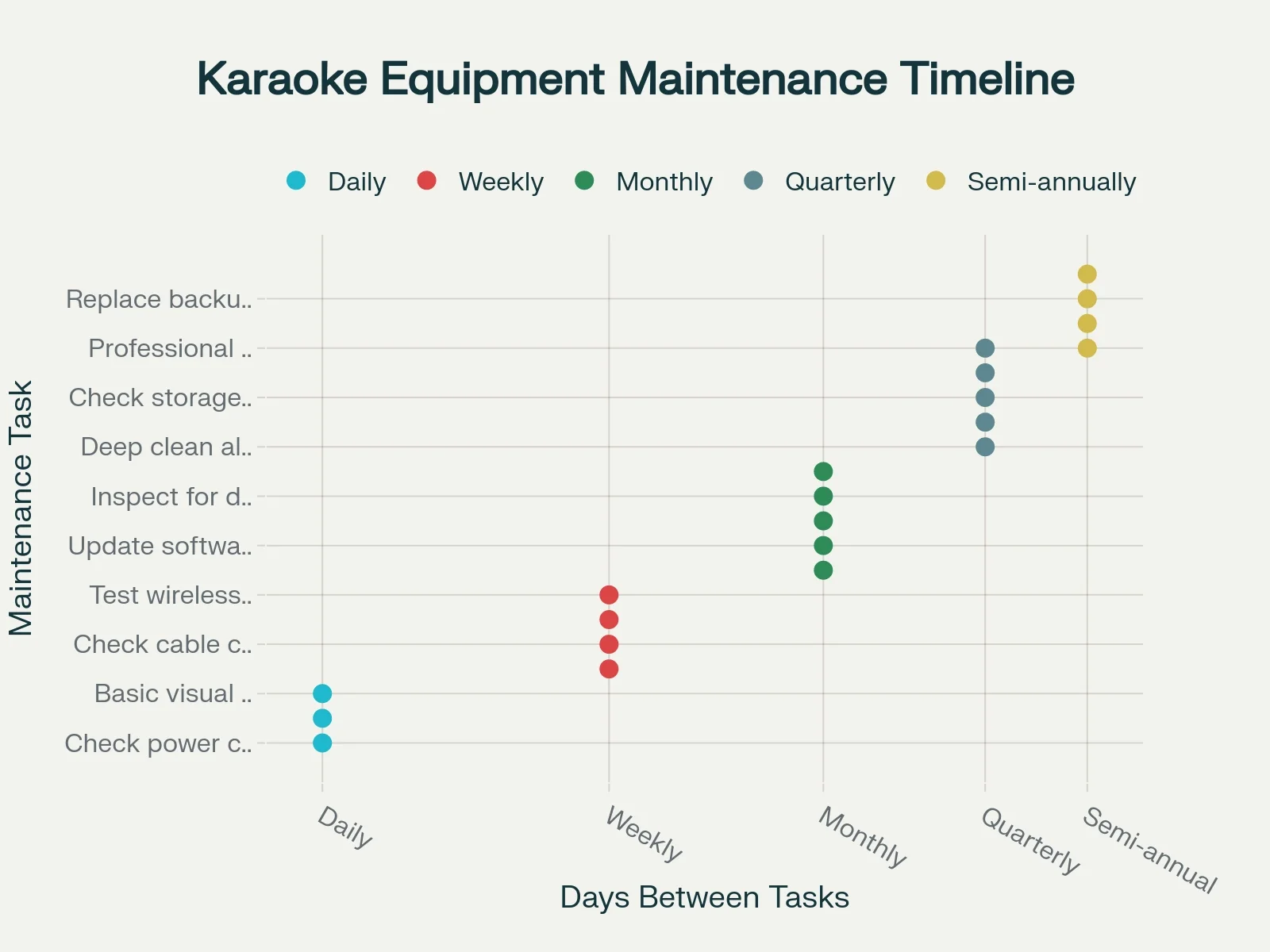Karaoke Machine Maintenance: Tips for Smooth-Running Nights
Ready to keep those karaoke nights pitch-perfect? If the thought of technical glitches and flat notes sends shivers down your spine, this guide is your backstage pass to smooth-running events, happy guests, and standing ovations all round. When it comes to karaoke machine maintenance, a systematic tune-up routine keeps your professional karaoke software, hardware, and wireless microphones singing sweetly long after last orders.
Learn helpful ways to improve system reliability, preserve your investment, and prevent damage, because it’s all about getting your equipment set to “Encore!” every single time.
Essential Daily and Weekly Karaoke Equipment Maintenance Tasks
When you're hosting karaoke at your bar, downtime is not on the playlist. Daily and weekly checks are the star performers in preventing unexpected failures. These tasks are intended for operators and venue managers who want equipment to work every night, delivering karaoke fun to every guest.
Daily Maintenance Checklist
☐ Verify all power systems and surge protectors are plugged in securely and showing correct voltage.
☐ Test each microphone, wired and wireless, for connectivity, battery levels, and sound clarity.
☐ Inspect all cables for visible damage, strain, or loosened connections.
☐ Check the wireless signal strength and range; address any dropouts.
☐ Ensure software interfaces load smoothly and display correct playlists.
Check your karaoke layout or karaoke room is free from obstructions and trip hazards.
Implementing these checks daily helps protect your investment and links directly to monthly deep-cleaning procedures for long-term system health.
Power System and Connection Verification Procedures
Reliable performances depend on stable power. Shocking power issues can turn your karaoke night into a comedy of errors, so verifying electrical connections is critical.
Operators should use proper outlet testers to confirm that sockets are grounded and free from faults. All surge protectors must be checked before each session, their lights and indicators help spot issues. For portable units, always confirm adapters provide 9V DC, and use voltage regulators for added protection where possible. Damaged power cables must be replaced promptly to prevent further equipment damage.
Electrical safety matters! According to the Occupational Safety and Health Administration, only use surge-protected outlets and never overload extension leads. Keep power adapters dust-free, check for heat build-up, and always disconnect everything before cleaning.
Microphone Function Testing and Quick Troubleshooting
No one wants a mic drop-out halfway through “Bohemian Rhapsody.” Microphones, especially wireless, require careful daily attention to keep vocals sounding clear.
Systematic Testing:
Wired mics: Check cable connections for secure fit, test with sound checks using the mixer, and assess for static or crackling (often caused by cable wear).
Wireless mics: Inspect battery levels and replace regularly. Confirm receivers are connecting within intended signal range (typically 10–30 metres for pro systems). Avoid interference by scanning for available frequency bands if issues arise.
Quick troubleshooting includes swapping batteries, reseating connectors, and temporarily switching to backup units during events. If continual issues persist, perform a full spectrum scan and check for nearby electronics that may cause frequency interference. Well-maintained microphones deliver excellent audio quality, protect user health, and keep the crowd singing on key.
Monthly Deep Cleaning Procedures for Karaoke Systems
Give your karaoke gear a spa day each month! A monthly deep clean maintains both sound quality and hygiene, extending the lifespan of audio equipment and boosting customer confidence.
Hello, World!
Always use products intended for electronic cleaning. Protect internal components from liquid ingress and ensure everything dries completely before use to prevent corrosion or short-circuits. These monthly routines set the stage for deeper quarterly maintenance.
Professional Microphone Cleaning and Sanitisation Methods
Microphones should be treated like fine musical instruments: cleaned, disinfected, and protected. Begin by carefully removing the grille and foam windscreen. Wash these in warm, soapy water (not hot,35–40°C is ideal) and air-dry thoroughly (minimum 1 hour). For sanitisation, apply 70% isopropyl alcohol using a clean brush or cloth, making sure to avoid internal electronics. Reassembly can occur once all parts are dry.
Disinfecting microphones reduces bacteria and viral transmission risk, especially important for multi-user events. Health safety protocols recommend this procedure before and after every session. Never use bleach or abrasive chemicals; stick with alcohol-based agents for both effectiveness and equipment safety.
Speaker and Amplifier Dust Removal Techniques
Dust build-up on speakers and amplifiers can make the entire system sound off-key and even lead to overheating. Operators should use compressed air to clear grilles and ventilation slots, followed by a soft brush for stubborn accumulations. Regular cleaning, at least monthly, keeps airflow optimal and prevents component degradation.
Preventive strategies include keeping equipment covered when not in use, storing away from busy walkways, and scheduling regular cleanouts, especially after large events. A clean speaker is a happy speaker, ready to pump out those power ballads.
Wireless Microphone Battery and Signal Maintenance
Wireless systems are music to everyone’s ears, until batteries fail or signals falter. Here's how to keep the chorus continuous:
Always charge batteries fully before events; replace after every 8–10 hours of use.
Store spare batteries in a cool, dry place, and rotate stock regularly.
Clean battery contacts monthly with isopropyl alcohol to prevent corrosion (especially in humid environments).
Optimize antennas, position upright and clear of obstructions for best range.
Troubleshoot interference by scanning for clear frequency bands and avoiding Wi-Fi congestion.
Signal maintenance protects from unexpected fade-outs, while proper storage and rotation ensure reliable power for every gig.
Troubleshooting Common Karaoke System Problems
Even the best systems face occasional hiccups. With systematic troubleshooting, malfunctions don’t have to mean the end of the party, just a quick interlude!
Common problems stem from audio signal issues, connectivity failures, or user errors. Diagnostic flowcharts, quick-reference emergency repair guides, and backup units help operators resolve issues before anyone can say “Where’s the music?”
Use clear testing procedures: start by tracing audio from source to output (input -> mixer -> amp -> speakers). Check each component with quality meters and swap in backups as needed. For power or connectivity failures, test all connections, swap power adapters, and use battery backups in emergencies.
With good troubleshooting, preventive maintenance and training bar staff to run karaoke like pros, even the trickiest problem can be resolved quickly, meaning the show always continues!
Already using Lucky Voice karaoke systems? We're here Monday to Friday 9:00am to 5:00pm for all things karaoke, support and advice.
Closing Thoughts
Ready to say goodbye to technical blunders and hello to applause-worthy performances? This karaoke machine maintenance guide is the professional playbook to keep every night running smoothly, letting guests work the mic and belt out their favourites without a hiccup. Choose the right services, follow the helpful routines, and protect your investment so the business continues to hit all the high notes.
Want more details, product options, or tailored advice? At Lucky Voice, we’ve spent years perfecting the art of karaoke for business. Our karaoke software is built to handle the realities of hospitality while keeping the fun front and centre, helping you create a karaoke night that boosts your venue’s success, song after song.



